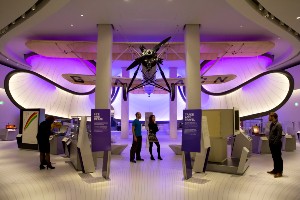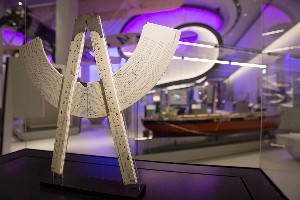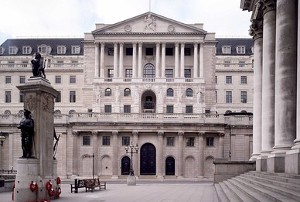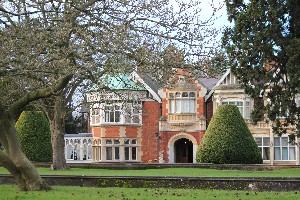4 great days out for maths lovers in and around London
Studying Maths at university is hard work, so it’s important to take a break and enjoy what London has to offer. For those of us that eat, sleep and breathe maths, here are some unmissable days out in and around the capital.
The 2022 QS Rankings have once again named London as the best student city in the world. There is so much to do and see here that sometimes it’s hard to know where to start. To get you started, we've picked some of our favourite maths-related places to visit.
The good news is that most of these activities are free and we have calculated journey times from the School of Mathematical Sciences, so that next time you’re at a loose end on campus, you've got something fun to go and do.
Mathematics: The Winton Gallery
Located within the Science Museum in Kensington, West London, this is our first stop.
 The exhibition brings together historical artefacts, remarkable stories, and breath-taking design to highlight the central role that maths plays in all our lives. It also shows us how mathematicians, their tools and ideas have helped build the modern world over the past four centuries.
The exhibition brings together historical artefacts, remarkable stories, and breath-taking design to highlight the central role that maths plays in all our lives. It also shows us how mathematicians, their tools and ideas have helped build the modern world over the past four centuries.
With such broad range of instruments and objects on display, it’ll be obvious to a maths student what some of them are, but others might surprise you and get you thinking about how mathematics is connected to so many other disciplines. Some of our favourite pieces include a beautiful Islamic astrolabe from the 17th century, which used ancient mathematical techniques to map the night sky. There is also an early example of the famous Enigma machine, which was designed to resist even the most advanced mathematical techniques for code breaking. The exhibition has been thoughtfully put together to tell the stories behind these pieces of equipment.
 Even if all these mathematical treasures weren’t on display, the exhibition room itself is worth a visit for the architecture alone. It was designed by the late Zaha Hadid, who is known for her dramatic architectural style and bold, expressive curves. What many people don’t know, is that Zaha Hadid also studied maths at university and this is when she first became interested in geometry. Mathematics and geometry have a strong connection with architecture, and she continued to examine these relationships throughout each of her projects. As Dame Zaha said, “When I was growing up in Iraq, math was an everyday part of life. We would play with math problems just as we would play with pens and paper to draw – math was like sketching.”
Even if all these mathematical treasures weren’t on display, the exhibition room itself is worth a visit for the architecture alone. It was designed by the late Zaha Hadid, who is known for her dramatic architectural style and bold, expressive curves. What many people don’t know, is that Zaha Hadid also studied maths at university and this is when she first became interested in geometry. Mathematics and geometry have a strong connection with architecture, and she continued to examine these relationships throughout each of her projects. As Dame Zaha said, “When I was growing up in Iraq, math was an everyday part of life. We would play with math problems just as we would play with pens and paper to draw – math was like sketching.”
Whatever it is that you love about maths, we’re pretty sure you’ll find it here.
Photo credit: Science Museum Group
How to get there: District Line from Stepney Green to South Kensington
Journey time: 40 mins
Entrance fee: Free
Visit if you like: artefacts, history, architecture
Bank of England
Lots of our students choose maths with a view to working in finance so we had to include the Bank of England.  Located in the heart of The City – and, unsurprisingly, right outside Bank station – this is a must for anyone that plans to work in the financial sector.
Located in the heart of The City – and, unsurprisingly, right outside Bank station – this is a must for anyone that plans to work in the financial sector.
Unlike the Winton Gallery, the Bank of England exhibitions are not focused on tools and instruments used in mathematics, but instead they explore the economic and financial history of the UK. You’ll learn all about obsolete financial practices such as the use of the tally stick. In Medieval times, people used a hazlewood stick carved with notches, which represented how much debt was owed. The stick was then split down the middle so that each party had a record of the debt. How times have changed!
 The exhibitions are full of other quirky gems such as coin sorters, pre-decimal cash registers and a pinwheel calculator, but our top pick for the Bank of England museum has to be the collection of coins and banknotes. Perfect for any numismatists and notaphilists (coin collectors and banknote collectors), it is incredible to see how these have developed and changed over time, incorporating new materials and technology.
The exhibitions are full of other quirky gems such as coin sorters, pre-decimal cash registers and a pinwheel calculator, but our top pick for the Bank of England museum has to be the collection of coins and banknotes. Perfect for any numismatists and notaphilists (coin collectors and banknote collectors), it is incredible to see how these have developed and changed over time, incorporating new materials and technology.
The Bank of England is also a great place to visit with friends or family that might not share your love for maths and the financial world. There are artworks displayed throughout the building and there’s a great self-guided walking tour of the city available until March 2022.
Photo credit: The Governor and Company of the Bank of England
How to get there: Bus no. 25 or District Line from Stepney Green to Monument or Central Line from Mile End to Bank
Journey time: 20 mins
Entrance fee: Free
Visit if you like: history, economics, coins and banknotes
Bletchley Park
Bletchley Park may look like a Victorian country mansion from the outside, but during World War II it was home to the Government Code and Cypher School (GC&CS) where a team of code breakers worked to decipher secret enemy codes.  Many of us think of Alan Turing as one of the most famous British mathematicians of all time, and he was a part of the team working at Bletchley House to decipher these codes.
Many of us think of Alan Turing as one of the most famous British mathematicians of all time, and he was a part of the team working at Bletchley House to decipher these codes.
Mathematics is central to code breaking and at Bletchley Park you can explore this relationship through immersive films, interactive displays, and museum collections. Our recommendation for Bletchley Park is Hut 11A where you’ll find a permanent exhibition that tells the story of the pioneering Bombe machine. The Bombe machines worked using the mathematical principle of contradiction to break enemy codes and hut 11A was their actual wartime location.
Like the Bank of England, this is a great one to visit with friends who might not be into maths and code breaking. There are plenty of exhibitions for history buffs and beautiful gardens to relax in the summer months.
How to get there from the School of Maths: Hammersmith and City Line from Stepney Green to Euston Square
Photo credit: Pixabay
National Rail from London Euston to Bletchley
Journey time: 1 hour 30
Entrance fee: £18:50 with your Queen Mary student ID
Visit if you like: history, codebreaking, computer science
History of Science Museum, Oxford
Another great day out near London is a visit to the History of Science Museum in Oxford. As the name suggests, this museum explores the history of mathematics and the fundamental role it plays in everything from architecture to sailing the seas. The exhibition focuses on instruments from the 16th to the 20th century with an emphasis on tools that were used for precise measurements. We really enjoyed learning more about sextants and octants, which were nautical navigation instruments that could measure the angular distances between objects.
The Mathematics exhibition is small, but the museum itself is well worth a day out with all kinds of science-related exhibitions from astronomy to physics to time keeping.
How to get there
Hammersmith and City Line to Paddington
National Rail from Paddington to Oxford
Journey time: 1 hour 45 mins
Entrance fee: Free
Visit if you like: historical artefacts, measurement tools, science
If you've got recommendations of other maths-related days out to add to this article, get in touch to share them with the QM maths community!